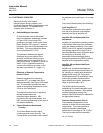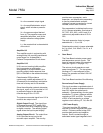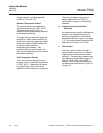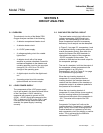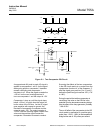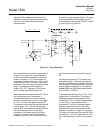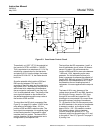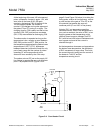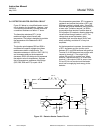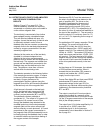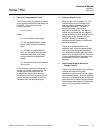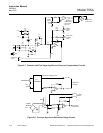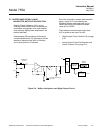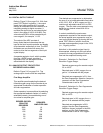
Instruction Manual
245364-V
May 2002
5-6 Circuit Analysis Rosemount Analytical Inc. A Division of Emerson Process Management
Model 755A
25 VAC
C31
.01uF
-
+
U6
R56
149K
Q2
CR12
120 V
RMS
Q3
R60
100
R61
2.0
R62
1K
R58
5M
R88
5M
R55
700K
R59
700K
RT1
+15V
-15V
2
3
6
HR1 +2
F1
CR6
WO4
5-4 DETECTOR HEATER CONTROL CIRCUIT
Figure 5-5 below is a simplified heater control
circuit drawing for the detector. Heaters 1 and
2 are actually connected in parallel and have
a combined resistance of about 17 ohms.
The thermistor resistance (RT1) in the
resistance bridge varies inversely with
temperature. The bridge is designed to maintain
the temperature of the detector at 150°F
(65.5°C).
The junction point between R55 and R56 is
maintained at a specific voltage since these
resistances maintain a definite ratio. The
thermistor resistance is 149 K at 150°F (65.5°C)
and increases rapidly as the temperature
decreases. R59 in this bridge circuit represents
the setpoint value for temperature. Suppose
that, at temperature, resistance of the bridge
(R55, R56, R59 and RT1) equals 149 K.
If the temperature goes down, RT1 increases in
resistance and causes the junction of RT1 and
R59 to go positive in voltage value. Since R55
and R56 are of equal resistance, their junction is
at zero volts. Therefore, terminal 3 of AR6 is
more positive than terminal 2 and the base of
Q2 is positive. Q2 conducts, allowing alternating
current to flow through heaters 1 and 2. The
voltage drop across the heaters, when
completely cold, would be about 20VAC and,
when controlling, would be AC of very low
amplitude.
As the temperature increases, the resistance
of RT1 decreases and the junction point
between RT1 and R59 becomes less positive.
Terminal 3 of AR6 becomes less positive with
respect to terminal 2. The output of AR
causes Q2 and Q3 to conduct less. When
terminal 3 equals terminal 2, or is less than
terminal 2, the output of AR6 is zero or less.
Q2 and Q3 do not conduct and the heater
would not be supplying heat energy to the
detector.
Figure 5-5. Detector Heater Control Circuit



